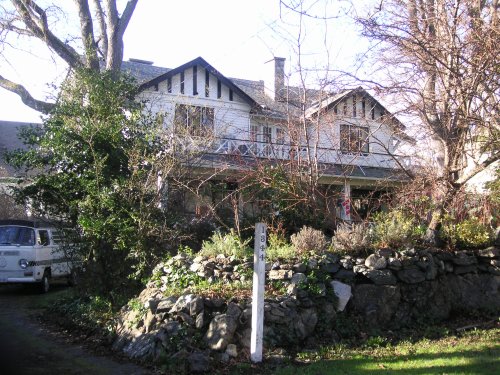1344 Victoria Avenue


1344 Victoria Avenue is is a symmetrical, two-storey residence with full basement in the Arts and Crafts style with Tudor Revival references; the main façade has prominent cross gables with half-timbering, at each end, and a full-length verandah. It is one of the larger homes in the area, with double-lot street frontage, and with mature cedars and oaks at the front of the property.
The house and its interior (living room, dining room and study) received Heritage Designation in 1997, By-Law #3925. It is an important component of Victoria Avenue’s heritage cluster and streetscape.
1344 Victoria Avenue is valued for its contribution to the social and economic history of Oak Bay. The house was built in 1912 on land that was formerly part of the land holdings of Joseph Despard Pemberton, the first Surveyor General of the Colony of Vancouver Island. This residence is a product of the building and development boom in Oak Bay prior to the First World War, when over 1,500 houses were constructed. After incorporation, in 1906, this part of Oak Bay became a popular residential area as a result of the improvement of transportation services, and civic amenities.
This residence has significance as one of the few surviving examples of the work of the firm of Wood and Richards. Wood and Richards (Frederick Wood and Reginald Percy James Richards) was a design-build firm which had a number of commissions for single-family residences in bungalow and British Arts and Crafts styles, primarily in the Fairfield neighbourhood. The firm was also commissioned to build four Soldiers’ Settlement Houses in Victoria in 1920. Fred Wood considered himself an architect, but never joined the Architects Institute of BC - the Professional Act was passed in 1921 by which time Wood had formed Wood-Foyster Construction Co. with partner K. B. Foyster.
The significance of this property is associated with its myriad owners and tenants, giving it a legacy and vibrancy that adds intangible intrinsic heritage value. The original owner, Marshall Pollock Gordon, was politically active and served as Reeve of Oak Bay in 1916. Later, the house was owned by the Honorable John Duncan MacLean, Premier of British Columbia (1927-1928) and CBE recipient. American Consul (1924-1934) George A. Bucklin, lived here in 1930. In 1940, Mrs. Holden, founder of the local Alliance Francaise, was a tenant. For many years this house has been associated with the local artistic community: nationally recognized textile artist Carole Sabiston, recipient of many prestigious awards amongst which is the Order of British Columbia, lived here for a period; later the house was home to Richard Simmins, Director of the Art Gallery of Greater Victoria (1977-1978); and, since 1972, it has been owned by the internationally award-winning artist Dr. Pat Martin Bates – member of the Royal Canadian Academy, and Professor Emeritus at the University of Victoria. The house has been a meeting place for the Limners, a group of Victoria artists and writers.
- setting on edge of double lot
- residential setback, location near Oak Bay Avenue amongst other heritage homes
- form, scale and massing
- side-gable roof with cross gables
- wood frame construction with granite foundation
- style details such as: symmetrical façade; full length balcony and verandah; heavy eaves brackets; varied cladding materials
- original exterior architectural elements such as: wood front door with strap hinges, mailbox, and casement sidelights; ‘Chinaman’s door’; garage; cast iron coal chute
- fenestration, and window types such as: casements; fixed; multiple-assembly leaded stained glass; oculus
- original interior elements such as: granite fireplaces; woodwork including decorative, two toned parquet floor; door furniture; built-in cabinets; tiles; Tudor arches
- landscape features: double garage with strap hinged doors and stained glass; splayed granite stairs, stair cheeks and piers at principal entry
 Instagram
Instagram
 Facebook
Facebook
 Twitter
Follow @DistrictOakBay
Twitter
Follow @DistrictOakBay